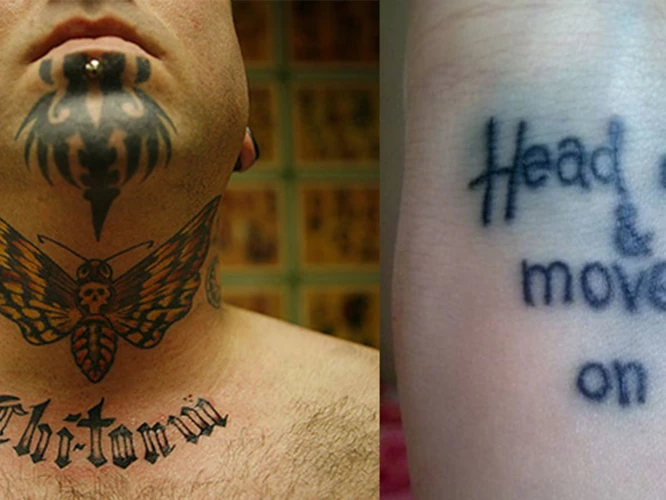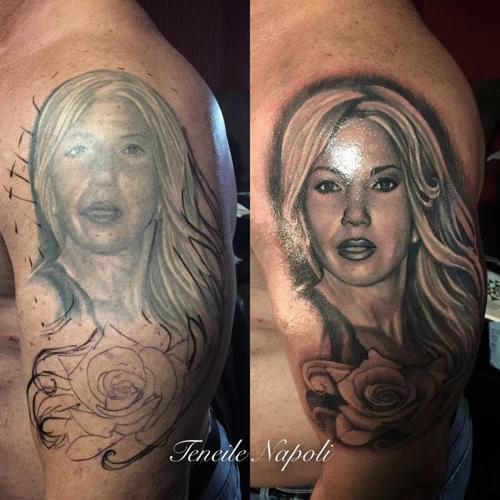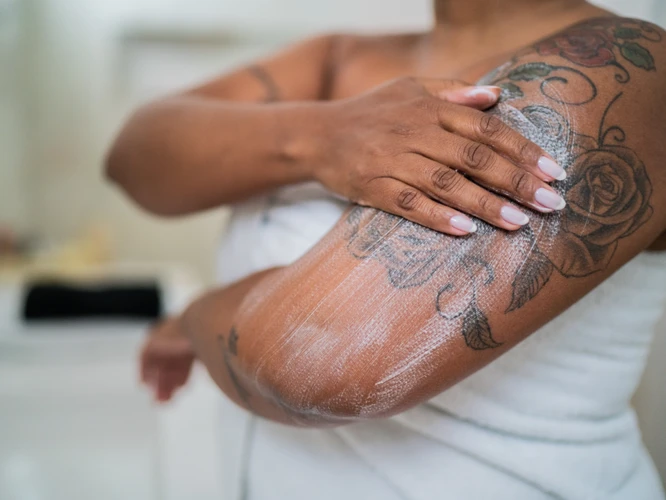Do you have a tattoo that you regret? Are you looking for ways on how to fix tattoo mistakes? If so, then you have come to the right place. In this article, we will provide you with seven tips for avoiding ink regret. We will discuss how to choose a qualified tattoo artist, how to choose the right design, and how to care for your tattoo to ensure that it looks its best. By following these tips, you will be able to make sure that your tattoo is one that you will be proud to show off.
Contents
Reasons for Bad Tattoo

Color Fading
One of the most common problems with tattoos is color fading over time. This typically occurs due to improper application of the ink, or because the skin wasn’t properly healed before having the tattoo applied. To prevent this issue, it’s important to ensure that the skin is correctly healed before getting a tattoo, and that the artist is using high-quality, long-lasting ink.
Shaky Lines
Another common issue with tattoos is shaky lines. This can be caused by an inexperienced artist, or by an artist who is using the wrong tools. To avoid this, it’s important to make sure that the artist is experienced and knowledgeable about what they are doing, and that they are using the right tools to ensure that the lines are as even and clean as possible.
Incomplete Coverage
In some cases, tattoos can have incomplete coverage, which can result in a patchy, uneven look. This can be caused by an inexperienced artist, or by an artist using the wrong needle or ink. To prevent this from happening, it’s important to make sure the artist is experienced and knowledgeable about their craft, and that they are using the right tools for the job.
If you find yourself with a bad tattoo, there are ways to fix a bad tattoo. From laser treatments to cover-ups, there are a few options available to give you the look you desire.
Fixing a Bad Tattoo

Color Fading
When it comes to fixing a bad tattoo, color fading is the most common issue. Over time, the colors may fade, making the tattoo look less vibrant. To fix color fading, it is important to use a high-quality tattoo ink and to regularly touch up the tattoo.
Shaky Lines
Another common issue with tattoos is shaky lines. This can happen if the artist is inexperienced or if the tattoo was done in a hurry. To fix shaky lines, it is important to find an experienced artist who can re-draw the lines of the tattoo to make them look more even and consistent.
Incomplete Coverage
In some cases, a tattoo may not have been applied properly, resulting in incomplete coverage. To fix this issue, it is important to make sure the artist is using a high-quality tattoo ink and that they are applying it properly. Why are my tattoo lines shaky? If you have an incomplete coverage issue, it is important to ask the artist questions to ensure that they are using the best techniques to apply the ink.
Touch Up Procedures

Color Retouching
Tattoo color retouching is a great way to bring back the vibrancy of a fading tattoo. By adding a few extra layers of ink, the tattoo can be made to look as good as new. Additionally, if the tattoo has become too light due to poor aftercare, color retouching can be used to restore its original vibrancy. When it comes to how to fix shaky tattoo lines, color retouching is an excellent way to do it.
Adding Finishing Details
If a tattoo is looking a bit dull, adding some finishing details can bring it back to life. Finishing details such as shading, highlights, and accents can really make a tattoo stand out. Additionally, they can be used to cover up any mistakes that may have been made during the tattooing process.
Covering Up Mistakes
If a mistake was made during the tattooing process, it can be covered up with another design. This can be a great way to fix a tattoo that you may not be happy with. Additionally, it can be used to improve a tattoo that has already been done, and it can be used to cover up any mistakes that may have been made.
Aftercare

Keeping the Area Clean
Proper hygiene is key to making sure your tattoo heals correctly and remains vibrant for years to come. You should always wash your hands before touching the tattoo and then gently cleanse the area with an antibacterial soap. Pat the area dry with a clean towel and allow it to air dry for a few minutes before applying any ointment.
Applying Ointment
Ointment helps to lock in moisture and protect the skin while it heals. Apply a thin layer of ointment to the tattoo twice a day, or as directed by your artist. Gently rub the ointment into the skin, making sure it is completely absorbed. Do not over-apply ointment, as this can cause the skin to become too soft and prone to infection.
Avoiding Sun Exposure
Protecting your tattoo from the sun is essential for keeping it looking its best for years to come. Keep the area covered with clothing or a bandage when out in the sun, and always use a high-SPF sunscreen when exposed to the sun. It’s best to avoid direct sunlight for at least two weeks after getting your tattoo.
Cost
- Research costs: Before getting a tattoo, make sure to research the cost and the design you want. Be sure to ask if the artist charges by the hour or by the tattoo.
- Removal cost: Laser tattoo removal can be expensive, so it’s important to think about the possible cost before getting a tattoo.
- Aftercare cost: Taking proper aftercare of a tattoo can be costly, so make sure to factor that into your budget when getting a tattoo.
Frequently Asked Questions
What should I do if I am unhappy with the result of my tattoo?
1. Talk to your tattoo artist: Immediately contact your tattoo artist and explain your dissatisfaction. Your artist may be able to offer a free touch-up to improve the design.
2. Consider laser tattoo removal: Laser tattoo removal is an effective way to lighten or completely remove a tattoo.
3. Cover up the existing tattoo: Tattoo cover-up involves inking a new design over your existing tattoo. Your artist will help you choose a design that suits your needs and covers the existing tattoo.
4. Go for a cosmetic tattoo: A cosmetic tattoo, also known as permanent make-up, can be used to cover up an existing tattoo. This procedure involves using a special pigment that is implanted into the skin. The pigment will gradually fade over time.
Is it Possible to Change the Design of an Existing Tattoo?
Yes, it is possible to change the design of an existing tattoo. While the process will require some additional time and cost, certain techniques can be used to alter the design of a tattoo to create a more desired result. For example, laser tattoo removal can be used to lighten certain areas of the tattoo, while shading, color, and line work can be added to alter the overall design. Additionally, a tattoo artist may be able to cover up parts of the existing tattoo with a new design.
What are the Risks Associated with Getting a Tattoo?
Getting a tattoo carries the risk of infection, allergic reaction to the tattoo dye, and a permanent reminder of a decision you may later regret. Infections can cause scarring, and can be life-threatening if not treated promptly. Allergic reactions can cause skin irritation, swelling and rashes. There is also the risk of nerve damage if the needle used for the tattoo penetrates too deep into the skin. Additionally, tattoos can be difficult to remove, so make sure that you are comfortable with the design and placement before getting a tattoo.
What are the best ways to ensure a successful tattoo experience?
- Choose a qualified tattoo artist – Before committing to a tattoo, be sure to do your research and select a qualified artist. Make sure you are comfortable with the artist and their work before getting inked.
- Be prepared for the cost – Tattoos can be expensive, so make sure you factor in the cost of the tattoo, supplies, and any additional touch-ups that may be needed.
- Be prepared for the pain – Tattoos can hurt, so make sure you’re mentally and physically prepared for the pain. Also, consider taking an over-the-counter pain reliever before and after the session.
- Choose the right design – It’s important to choose a design that you’re sure you won’t regret. Take your time and research different designs to make sure you’re picking the right one.
- Take care of your tattoo – After getting a tattoo, make sure to follow the artist’s instructions for taking care of it. This includes keeping it clean, applying a moisturizer, and avoiding direct sunlight.
- Be aware of potential risks – Tattoos can come with risks, such as infections and allergic reactions, so make sure to discuss these with your artist before getting inked.
- Be patient – Don’t rush the process. Take your time and be sure to think about your decision before committing to a tattoo.
Is it Possible to Remove a Tattoo Completely?
Yes: It is possible to remove a tattoo completely using laser tattoo removal. This is a relatively safe procedure, and the results can be impressive. Depending on the size and color of the tattoo, it may take several sessions to fully remove it, and the results may not be perfect.
No: Unfortunately, it is not always possible to completely remove a tattoo. In some cases, a tattoo may be too large or too deep to be removed completely. In this case, it may be possible to lighten it or blur the edges, but it may still be visible.
- Laser Tattoo Removal: This is the most common method of tattoo removal. It uses a laser to break down the ink particles, which are then absorbed by the body. It is most effective on small, simple tattoos, and may take several sessions to achieve the desired results.
- Dermabrasion: This technique involves using a wand to abrade the skin, which breaks up the ink particles. Dermabrasion is often used in combination with laser tattoo removal.
- Tattoo Removal Creams: These creams contain chemicals that break down the ink particles. They are often not effective, and may cause skin irritation.
- Surgery: In some cases, surgery may be necessary to remove a tattoo. This is usually done as a last resort and is not recommended, as it can be painful and may leave scarring.
Overall, it is possible to remove a tattoo completely, but it may not be possible in all cases. It is important to consult with a professional to determine the best course of action for your specific situation.
Conclusion
Tattoo regret is a common problem, but it doesn’t have to be permanent. By carefully considering the placement, design, and aftercare of your tattoo, you can ensure that it will last as long as you want it to. Taking the time to research the tattoo artist and their history, as well as remembering to keep your tattoo clean and moisturized, are essential steps for avoiding ink regret. Following these tips will help you make the most of your tattoo and ensure it looks its best for years to come.